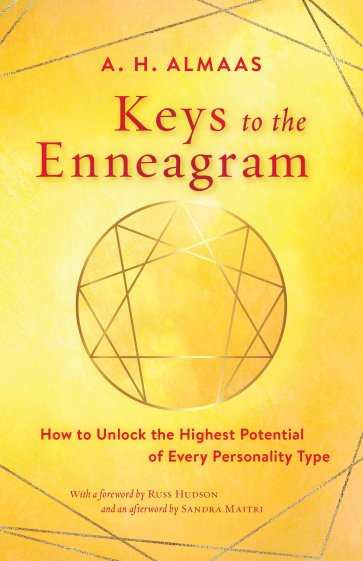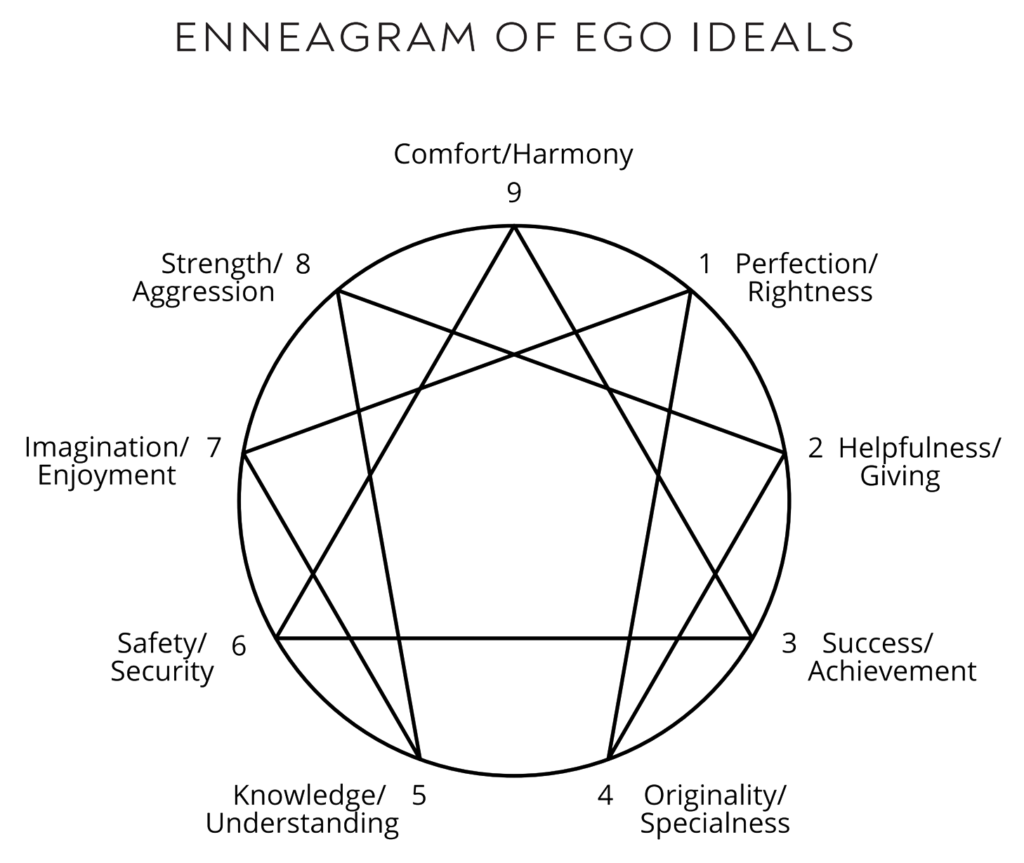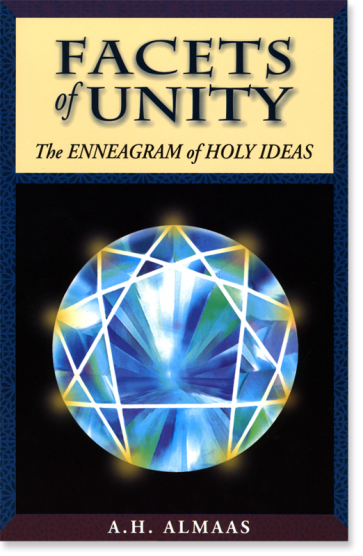The Enneagram of Personality is a detailed map that shows us how to work with our personality and relax the hold of historical patterns or “fixations,” which disconnect us from the spiritual ground of reality.
Typically, people orient to an “ego ideal” – a vision of being and functioning as our best self – to compensate and layer over the disconnection from spirit.

The ego-ideal is not the key that we need to unravel the enneagram fixation and its hold on us.
That key is the esoteric secret taught in the Diamond Approach and revealed in this book. – A. H. Almaas, Author, Keys to the Enneagram

“To some extent, the typology and the symbol can be understood intellectually, and in some parts of the enneagram community, things stop right there. But the third element, the system of practice behind it, is another matter. In my view, the enneagram does not really come to life to assist us in our development without this vital third component. And it is here that the importance of A. H. Almaas, and the work he describes in this book, becomes most central and evident.” – Russ Hudson
Boulder Book Store sponsored event with Russ Hudson and A. H. Almaas
Banyen Books Interview ~ Keys to the Enneagram

When we recognize that we avoid or fear particular states or experiences, it can help reveal what our enneagram fixation is. One of the nine Avoidances in the diagram above may resonate with you more than the others, shedding light on your enneatype.
“In Keys to the Enneagram, Almaas elucidates the specific inner relationships between core essential states of the soul, their perceived loss in childhood, and the psychological defenses and difficulties that arise to cover over the apparent loss of essential qualities. These patterns are specific and really do constitute the core of any real enneagram work.”
“Of course, the more you acquire a dedicated practice to cultivate presence and the capacity to observe the activities of your inner world, the more this book will come to life and be a tremendous friend to you on your journey. I feel these teachings are an enormous gift to anyone engaged in the process of awakening, regardless of your path or faith orientation.”
“In 1999, Almaas wrote an enneagram book called Facets of Unity, and it remains the foundational text for the teachings of the holy ideas—advanced material on the various nondual perceptions of reality that arise when the mind is liberated from each point’s characteristic fixation. This is a hugely important book for advanced students, but Almaas saw that for many of the students of the enneagram, a more introductory approach to using the Diamond Approach in conjunction with the enneagram was required, and thus this book came into being. If you sincerely work with the practices and ideas in this book, you will develop a deeper understanding of yourself and of the topics in Facets of Unity.” – Russ Hudson, from the Forward
Byron Brown, author, and editor writes: “Keys to the Enneagram looks at a different dimension of the enneagram of personality. As we know, each enneatype takes on certain strategies and behaviors based on its distorted view of reality. Through the lens presented in Keys, we see that these manifestations are shaped by a belief that there is an ideal way to function and appear. This is referred to as the ego ideal.”

Byron explains how we can go from fixating on our ego ideals to recovering our deep connection to the ground of our reality:
“The holy idea is the deeper perspective of truth that is lost when the enneatype becomes disconnected from its deeper ground. The ego-ideal is a vision of optimal functioning that the enneatype orients toward to compensate for this disconnection. What Keys does is elucidate the spiritual qualities that the nine ego ideals are unconsciously mimicking. These qualities are actual states of being that shape and color our individual consciousness from the inside. If recognized and embodied, they will relax the fixated orientation of the enneatype and open the way for recovering the perspective of the spiritual ground of reality.
There is a fundamental principle of the Diamond Approach path that Almaas is drawing on in sharing his understanding of these keys to the Enneagram. This is the recognition that the ego-self is not fundamentally original; it cannot develop original solutions for life’s problems. Only Being itself—the living existence of consciousness—can respond to reality in creative and original ways. Ego’s responses to life are a product of its ideas and learning— concepts, beliefs, plans, judgments, and conditioning from the past.
Since ego lacks beingness–direct immediate existence–it can only construct responses from what it has already known. This means it cannot create anything new or fresh. It must copy or restructure something from the past. All of its forms and responses to life are some effort to mimic or simulate what Being has originally manifested. Thus ego gets all of its ideas, all of its strategies, all of its possibilities from Being, usually without knowing it.”
Almaas describes the impetus for writing Keys to the Enneagram:
“I was a member of Naranjo’s first SAT (Seekers after Truth) group, and I learned many of the levels of the enneagram from him. The enneagram is fundamentally a dynamic flow that connects nine points around a circle by a nonlinear path. Gurdjieff was one of the first to use this flow as it applied to many areas of experience in the human (and natural) world. Ichazo focused on it as a tool of human study. Naranjo used it as a psychological tool to investigate the ego personality that keeps our essential/spiritual nature hidden or inaccessible. Based on his work and that of other followers of Ichazo, the enneagram has become known almost exclusively for its application to patterns in human psychology and spiritual development. In this context, the nine points have become more of the focus, and the flow between them is less understood and often forgotten.
It has been twenty years since Facets of Unity was published. Only recently have I realized that I have more understanding to share about the enneagram, which has led to the creation of this book as a companion to the first. I have been feeling the necessity to complete that work, specifically to write about the fixation shells, for in these shells lie the secret keys that we need to unlock each fixation and tackle the difficult and deep task of working through the inner cores. I use the word key to refer to an essential aspect or quality that reveals the inner logic of each fixation, while also providing a means to “unfix” it. I am not going to be discussing the details of each type and its fixation. Many authors, including Sandra Maitri, Claudio Naranjo, Helen Palmer, and Russ Hudson, have done a great job in spelling these out. Rather, I will use the knowledge of the Enneagram to find the key to each type that is necessary to gain freedom from the fixation.” – A. H. Almaas, from the Introduction to Keys to the Enneagram
ONE’S UNIQUE ESSENTIAL ENDOWMENT
“The insight into the ego-deal of each type is that it is a facsimile, an imitation of something else, at best an approximation of something real and authentic that is beyond ego. The ego-ideal does not simply arise out of our conditioning. Nor do we learn it from idealizing somebody else. It is not born from our longing to be like our childhood hero. In fact, it is the other way around: we find the hero who corresponds to our ideal. What I saw was that we were not only born with one holy idea being dominant but also with a particular quality of pure consciousness or true nature.
“There are two ways of accessing our unique essential endowment, which is the quality of Being, or the eternal spirit that our ego ideal tries to emulate. One is through the ego ideal. By seeing and understanding our particular ego ideal, we approach the essential quality it is trying to emulate. By understanding how the ego ideal patterns our personality on the one hand and how the characteristics and traits of our personality reflect the essential quality on the other, we may be able to recognize the quality itself. But it is only when we know that our ego-ideal is not the real thing—that it is a facsimile, a conceptual approximation, just an idea or picture in our mind—that we can have the openness, the space for that essential quality to arise.
“The second way to access our essential endowment is more direct. It involves utilizing the knowledge and wisdom of the Diamond Approach to open up to our being and recognize this essential presence.” – A. H. Almaas
In this book, Almaas has fully developed his understanding of the idealized aspects and indicated the link between them and the holy ideas. He shows how the idealized aspects characterize the shell or outer layer of each type and that penetrating the shell allows us to more easily work with the core of each type, the holy ideas, and the tendencies that arise in the wake of their loss.
This penetration allows us to realize experientially the qualities that each enneatype mimics. But, like everything else on the path, this penetration has to be rooted in our direct experience. Almaas’s methodology for this aspect of our journey is that of the Diamond Approach. As he has indicated, the first step to a lived understanding is getting in touch with our bodies. The reason for this is that the different qualities of our deepest nature that are the idealized aspects are only going to be found right here, inside each of us. To find them, or more exactly to open to them, we also have to be right here, present in the immediacy of our experience. This begins with our physical form, our body, because it’s only here, in our personal location, that we can know the presence that characterizes these differentiations of our deepest nature.
What we find is that the soul child of each type is patterned by the ego ideal of the type before it in the inner movement of the Enneagram. So, type Six’s soul child is characterized by the Nine ideal, which is boundless love. Type Seven’s soul child is type Five, which is patterned by its idealization of diamond guidance. At this stage, however, it is not just a reflection or imitation of the idealized aspect. Because the soul child is still not completely structured by mind and memory, it is still open to its natural essential endowment. So, the soul child of type Seven is a Five child with the presence of diamond guidance in its experience. It is essential intellect that is mixed with imitations of it and some distortions. Mixed into all of that is the usual conditioning from childhood experience of the child’s interactions with their parents or parental figures. – Sandra Maitri, Author

For those who want additional material to help them explore the enneagram, Almaas’s earlier book, Facets of Unity, might be a good next step. Below is some additional information on that work.
To pursue the personal exploration suggested in this book, you will need some skill in psychological processing, which is part of what we do through the practice of inquiry in the Diamond Approach teaching. The point of learning the principles of this practice is that it reveals more than the workings of our mind and emotions. It enhances psychological processing, transforming it into a spiritual practice that extends our explorations into the spiritual sphere, helping us delve more deeply into our true being, our nature, and its qualities. We are exploring some of the qualities in this book that are relevant to the enneagram. And all of them are useful in the practice of inquiry, which can loosen the knots of the fixations and their cores.
Each Holy Idea represents a particular direct perception of reality as a specific characteristic or facet of the unobscured perception of what is. The nine Ideas, then, provide us with a comprehensive view of objective reality. The transmitted view of the enneagram is that each enneatype fixation is the expression of a limited mental perspective on reality and that each of the nine egoic perspectives is the direct result of the loss or absence of the enlightened perception of one of the Holy Ideas. The enneagram of fixations reflects the deluded or egoic view of reality, expressing the loss of the enlightened view, which is represented by the enneagram of Holy Ideas.
A Holy Idea is a particular unconditioned, and hence objective, experiential understanding of reality. For example, from the perspective of one Holy Idea, reality is experienced as a nondual unity of Being, and the loss or absence of this Holy Idea leads to the delusion of duality, which manifests in the conviction that there are ultimately discrete objects in reality. There are nine specific delusions reflecting the loss or absence of the nine Holy Ideas. These delusions function as the primary principles of egoic existence. Each delusion forms the center of a psychological complex, which we view as the core of that particular fixation.
The Holy Ideas constitute a map of the view of reality as unity. Each Holy Idea is a view of reality that reflects an understanding of the wholeness and unity of the world or universe, of human beings, and of the functioning of reality. The understanding of unity—the nonduality of the various elements and dimensions of existence and manifestation—is an element of every traditional spiritual understanding. Both Eastern and Western teachings that include a method of inner work toward realization of reality inevitably lead to the perception of the nonseparateness of human and world, physical world and consciousness, divine and mundane. Many of these teachings understand human suffering to arise from ignorance of this truth, that is, separation or alienation from awareness of the sacred or the real. – A. H. Almaas, Facets of Unity
